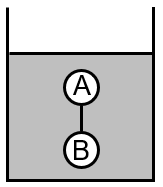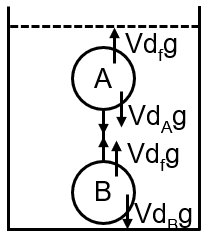Two solid spheres A and B of equal volumes but of different densities dA and dB are connected by a string. They are fully immersed in a fluid of density dF. They get arranged into an equilibrium state as show in the figure with a tension in the string. The arrangement is possible only if :


system will be in equilibrium with tension in string only if df > dA and dB > df. If both A & B are considered as a system then
2Vdfg = V (dA + dB)g dA + dB = 2df
This problem involves two spheres of equal volume but different densities connected by a string and fully immersed in a fluid. For the system to be in equilibrium with tension in the string, we must analyze the forces acting on each sphere.
Step 1: Identify Forces
For any object submerged in a fluid, two primary forces act:
Step 2: Analyze Equilibrium for Each Sphere
From the figure, sphere A is above sphere B. For equilibrium, the net force on each sphere must be zero.
For sphere A (top sphere):
For sphere B (bottom sphere):
Step 3: Combine the Equations
From sphere A:
From sphere B:
Equating the two expressions for tension:
Cancel from all terms:
Rearranging:
So, .
Step 4: Check the Conditions
From the analysis:
Final Answer: The arrangement is possible only if , , and . Among the options, is correct and necessary.
Buoyancy and Archimedes' Principle:
Archimedes' principle states that the buoyant force on an object immersed in a fluid is equal to the weight of the fluid displaced by the object. Formula: , where is the volume of displaced fluid.
Equilibrium of Forces:
For an object to be in equilibrium, the vector sum of all forces acting on it must be zero. This is applied separately to each sphere in the system.
Density and Volume:
Density () is mass per unit volume. Weight is . For objects of equal volume, weight is directly proportional to density.